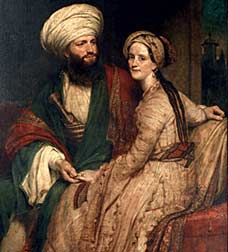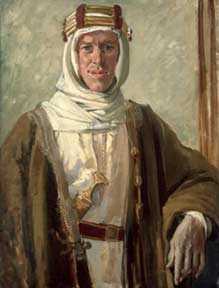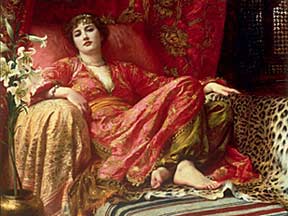The Orientalists: Then and Now
The Lure of the East: British Orientalist Painting, is an important exhibition running in London at the Tate Britain from June 4th, 2008 through August 31st, 2008. The exhibit provides a somewhat critical look at Orientalism, the genre commonly associated with nineteenth-century Western artists who depicted the peoples and cultures of an imagined Near and Middle East. The Tate is displaying over 120 paintings, prints and drawings created by British artists from 1780 to 1930, and given the current occupation of Iraq – the timely exhibit inadvertently calls into question the West’s modern-day accepted wisdom regarding the Islamic world.

Until the late 1960s, Orientalist painting was purely evaluated on aesthetic terms, with little or no attention paid to the socio-political aspects of the works. Aware of the failing to take into account the legacy of colonialism, the Tate exhibit offers a reassessment of Orientalist painting. As part of that reexamination, the museum presented a June 12th symposium titled Orientalism Revisited: Art and the Politics of Representation – a day long panel discussion by distinguished professionals and intellectuals on the subject of “art, politics, and representation of the nineteenth century to today.” The entire exhibition was curated with the views of scholar and writer, Edward Said (pronounced sah-EED) in mind. In the Tate’s words:
“In the 1970s the Palestinian-American academic Edward Said published his treatise on Orientalism, initiating a global debate over Western representations of the Middle East. For many, such representations now appeared to be a sequence of fictions serving the West’s desire for superiority and control over the East. The argument for and against Said’s Orientalism has continued for thirty years. Its resonance for an exhibition such as this one, however, is as strong as ever given that, by the 1920s (the end of the period covered by the exhibition), Britain was in direct control of much of the newly-abolished Ottoman Empire, including Egypt, Palestine and Iraq. As Said’s followers argued, these images cannot be viewed in isolation from their wider political and cultural context.”
Representations of the “exotic Orient” have appeared in Western art from antiquity, but after General Napoleon Bonapart and his invading French army conquered Egypt in 1798, European penetration and colonization of the Near and Middle East began in earnest. There was a concomitant explosion of Orientalist painting that fed European flights of fancy regarding the entire region. Some Western artists actually traveled through the area, painting, sketching, and making field studies for works that would be created or finished in the studio – while many others never left their European homes, instead finding inspiration for their canvases from written accounts of life in the “Orient”. In either case, the artists approached their subjects with presumed Western superiority.

A long train of events brought ever more European artists and writers into the region after the French subjugated Egypt. France took possession of Algiers in 1830, and along with Great Britain and the Ottoman Empire – fought Russia for control of the Holy Land in the Crimean War of 1854-1856. The French built and opened the Egyptian Suez Canal in 1869, increasing European incursion into the region. The Ottoman Turkish Empire was itself finally dismembered at the close of World War I, with its territories of Syria, Lebanon, Iraq, Jordan, Palestine, Saudi Arabia, and Yemen becoming European possessions. While a good deal of Orientalist art is magnificent, that does not mean it should or can be disassociated from the European imperialist expansion it was a part of. As Said declared in Orientalism;
“One would find this kind of procedure less objectionable as political propaganda – which is what it is, of course – were it not accompanied by sermons on the objectivity, the fairness, the impartiality of a real historian, the implication always being that Muslims and Arabs cannot be objective but that Orientalists. . .writing about Muslims are, by definition, by training, by the mere fact of their Westernness. This is the culmination of Orientalism as a dogma that not only degrades its subject matter but also blinds its practitioners.”
While some Orientalist art depicted the Islamic world populated by a despotic and brutish race in need of being rescued by enlightened Europeans, not all of it was so odious. With a keen eye for observation, Orientalists created paintings and prints of nearly everything, from landscapes and cityscapes to portraits of the high ranking and the humble. If these works set Islamic peoples apart as exotic others, they also clearly expressed awe and wonderment over Near and Middle Eastern societies.
The French neo-classical painter Jean-Auguste-Dominique Ingres (1780-1867/pronunciation) was certainly not the only artist to misrepresent and mythologize harem life, but his Orientalist themed La Grande Odalisque (1814) and The Turkish Bath (1862) helped to permanently imprint upon the Western mind the archetypical vision of lascivious Arabs. Remarkably, Ingres never traveled to the Near or Middle East – his paintings were pure conjecture and created in his Paris studio. Moreover, since the harem was a women’s quarters whose entry was forbidden to all men, save for Eunuch guards – Western depictions of harem life were largely based on sheer fantasy, hearsay, and rumor.

From his studio in Paris the French Academic painter Jean-Léon Gérôme (1824-1904) painted pictures of harem life based on sketches of buildings he made while traveling through Egypt and Turkey. Into these backdrops he painted gorgeous Parisian models who posed as harem girls. In point of fact, of all the Orientalists who painted harem scenes, only the French Romantic painter Eugène Delacroix (1798-1853) actually managed to step inside of one.
Appointed to an official French delegation to Morocco in 1832, Delacroix made a four month trip to Morocco and the conquered nation of Algiers. He was infatuated by the Arab people, but no less inclined to have a distorted view of them than did his rival, Ingres. Delacroix wanted to visit a harem, but this proved impossible in Morocco because of stringent religious rules. Occupied Algiers however proved a different matter. A French harbor engineer “persuaded” a powerful Algerian to allow Delacroix a visit to his harem under a vow of secrecy. The artist spent hours sketching the women there, and said of them, “This is woman as I understand her, not thrown into the life of the world, but withdrawn at its heart as its most secret, delicious and moving fulfillment.”
Back home Delacroix would paint Women of Algiers in their apartment (1834) from the sketches made in Algiers. It would be a tour de force, possibly the most influential of all harem paintings. Renoir swore he could smell incense when close to the painting and Cézanne was effusive over the color of the slippers belonging to one of the odalisques, a red that “goes into one’s eyes like a glass of wine down one’s throat.”
Orientalism in art was by no means restricted to the 19th century – think of Matisse’s Odalisque in Red Trousers. Picasso ended up painting fifteen variations of Delacroix’s Women of Algiers. Orientalism in Western art, academia, and politics by no means melted away with the passage of time – it still informs our opinions and actions even today. Certainly those experts who assured us that “Liberating Iraq would be a cakewalk” were suffering from the latest virulent strain of Orientalism. As Dr. Said noted in the 2003 revised edition of Orientalism; “Without a well-organized sense that the people over there were not like ‘us’ and didn’t appreciate ‘our’ values – the very core of traditional orientalist dogma – there would have been no war.” Writing on the mess in the Middle East for The Independent from his home in Beirut, Lebanon, British reporter Robert Fisk said the following:
“I despair. The Tate has just sent me its magnificent book of orientalist paintings to coincide with its latest exhibition (The Lure of the East: British Orientalist Painting) and I am struck by the awesome beauty of this work. In the 19th century, our great painters wondered at the glories of the Orient. No more painters today. Instead, we send our photographers and they return with pictures of car bombs and body parts and blood and destroyed homes and Palestinians pleading for food and fuel and hooded gunmen on the streets of Beirut, yes, and dead Israelis too. The orientalists looked at the majesty of this place and today we look at the wasteland which we have helped to create.”
Fisk’s assessment is unquestionably a bleak one, but I find it difficult to disagree with. Putting aside all criticisms of Orientalist art, the fact that the West once found inspiration and bedazzling beauty in the Near and Middle East should jar our collective memory. If Western perceptions of “the Orient” focused on the mysterious, exotic, and sensual, there was always a subtext of evil, cruelty, and depravity. However, today we are being shown only the latter, and we have largely accepted this worldview. How we arrived at this historic juncture is not hard to determine, but a thorough reading of history regarding empire and imperialist depredations in the region is required for a full understanding of present circumstances. The Tate’s exhibition can be seen as one small step in acquiring such knowledge, especially now that the United Kingdom once again militarily occupies Iraq and Afghanistan, albeit as a junior partner in U.S. plans for the region.
I am left to wonder, not about the enormous influence Orientalist art had in times past, but how contemporary artists will act in response to the crisis in the Near and Middle East. Although a small layer of artists have dealt with the ongoing catastrophe, indifference or resignation still seems to be the art world’s general attitude. Artists can not permit impassiveness and lack of concern for the incalculable misery being experienced by humanity in the Near and Middle East to become the hallmarks of 21st art. The artistic community must refute the barbarity seen all around us – without prejudice, false hopes, or creating new strains of Orientalism.


